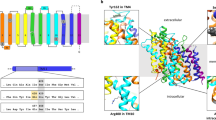Abstract
Pseudohypoaldosteronism type 1 (PHA1, OMIM 264350) is an uncommon inherited disorder characterized by salt-wasting and end-organ unrespon-siveness to mineralocorticoids1. A complete genome search using homozygosity mapping in eleven consanguineous families with PHA1 provided conclusive evidence of linkage with heterogeneity2. The disease locus mapped to chromosome 16p12.2–13.11 in six families and to 12p13.1–pter in the other five families. These two chromosomal regions harbour the genes encoding the three sub-units of the human amiloride sensitive epithelial sodium channel (hENaC): SCNN1B and SCNN1G on 16p and SCNN1A on 12p3,4. Our linkage results have been further supported by the recent report of mutations in the a and p subunit genes in PHA1 patients5. We now report the identification of a 3′ splice site mutation in SCNN1G (318-1 G→A) in three families showing linkage to 16p. Abnormal splicing results with the production of two messenger RNAs, one arising from activation of an adjacent cryptic splice site and the other from skipping of the downstream exon. The two corresponding mutant γhENaC subunits are predicted to have three highly conserved amino acids in the extracellular domain replaced by a novel amino acid (KYS106–108→N) and truncation from 649 to 134 amino acids respectively. These three families all originate from the Indian sub-continent and the probands have severe generalized PHA. They share a common haplotype which suggests the presence of a founder mutation in this sub-population.
This is a preview of subscription content, access via your institution
Access options
Subscribe to this journal
Receive 12 print issues and online access
$209.00 per year
only $17.42 per issue
Buy this article
- Purchase on Springer Link
- Instant access to full article PDF
Prices may be subject to local taxes which are calculated during checkout
Similar content being viewed by others
References
Komesaroff, P.A., Funder, J.W. & Fuller, P.J. Mineralocorticoid resistance. Baillieres Clin. Endocrinol. Metab. 8, 333–355 (1994).
Strautnieks, S.S. et al. Localisation of pseudohypoaldosteronism genes to chromosome 16p12.2–13.11 and 12p13.1–pter by homozygosity mapping. Hum. Mol. Genet. 5, 293–299 (1996).
Meisler, M.H., Barrow, L.L., Canessa, C.M. & Rossier, B.C. SCNN1, an epithelial cell sodium channel gene in the conserved linkage group on mouse chromosome 6 and human chromosome 12. Genomics 24, 185–186 (1994).
Voilley, N. et al. Cloning, chromosomal localisation and physical linkage of the β and γ subunits (SCNN1B and SCNN1G) of the human epithelial amiloride-sensitive sodium channel. Genomics 28, 560–565 (1995).
Chang, S.S. et al. Mutations in subunits of the epithelial sodium channel cause salt wasting with hyperkalaemic acidosis, pseudohypoaldosteronism type 1. Nature Genet. 12, 248–253 (1996).
Lingueglia, E., Voilley, N., Waldmann, R., Lazdunski, M. & Barbry, R. Expression cloning of an epithelial amiloride-sensitive Na+ channel. A new channel type with homologies to Caenomabditis elegans degenerins. FEBS. 318, 95–99 (1993).
Canessa, C.N. et al. Amiloride sensitive epithelial Na+ channel is made of three homologous subunits. Nature 367, 463–467 (1994).
McDonald, F.J., Price, M.P., Snyder, P.M. & Welsh, M.J. Cloning and expression of the β- and γ-subunits of the human epithelial sodium channel. Am. J. Physiol. 268, C1157–1163 (1995).
Fuller, C.M. et al. Cloning of a bovine renal epithelial Na+ channel subunit. Am. J. Physiol. 269, C641–654 (1995).
Padgett, R.A., Grabowski, P.J., Konarska, M.M., Seiler, S. & Sharp, P.A. Splicing of messenger RNA precursors. Ann. Rev. Biochem. 55, 1119–1150 (1986).
Shapiro, M.B. & Senapathy, P. RNA splice junctions of different classes of eukaryotes: sequence statistics and functional implications in gene expression. Nucl. Acids Res. 15, 7155–7174 (1987).
Shimkets, R.A. et al. Liddle's Syndrome: heritable human hypertension caused by mutations in the β subunit of the epithelial sodium channel. Cell 79, 407–414 (1994).
Hansson, J.H. et al. Hypertension caused by a truncated epithelial sodium channel γ subunit: genetic heterogeneity of Liddle syndrome. Nature Genet. 11, 76–82 (1995).
Snyder, P.M. et al. Mechanism by which Liddle's syndrome mutations increase activity of a human epithelial Na+ channel. Cell 83, 969–978 (1995).
Hong, K. & Driscoll, M. A transmembrane domain of the putative channel subunit MEC-4 influences mechanotransduction and neurodegeneration in C. elegans. Nature 367, 412–413 (1994).
Author information
Authors and Affiliations
Rights and permissions
About this article
Cite this article
Strautnieks, S., Thompson, R., Gardiner, R. et al. A novel spice–site mutation in the γ subunit of the epithelial sodium channel gene in three pseudohypoaldosteronism type 1 families. Nat Genet 13, 248–250 (1996). https://doi.org/10.1038/ng0696-248
Received:
Accepted:
Issue Date:
DOI: https://doi.org/10.1038/ng0696-248
This article is cited by
-
Role of αENaC in root resorption of adjacent teeth due to entirely impacted mandibular third molars
BMC Oral Health (2024)
-
The epithelial sodium channel has a role in breast cancer cell proliferation
Breast Cancer Research and Treatment (2021)
-
ENaC in Salt-Sensitive Hypertension: Kidney and Beyond
Current Hypertension Reports (2020)
-
Liddle syndrome due to a novel mutation in the γ subunit of the epithelial sodium channel (ENaC) in family from Russia: a case report
BMC Nephrology (2019)
-
Disorders of renal NaCl transport and implications for blood pressure regulation
Medizinische Genetik (2019)



